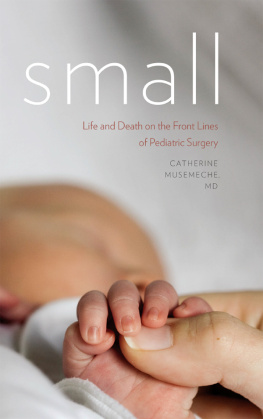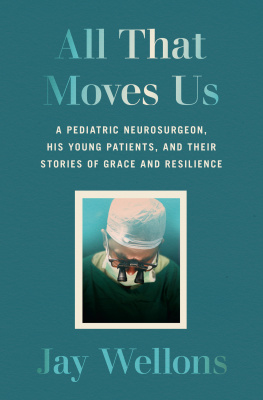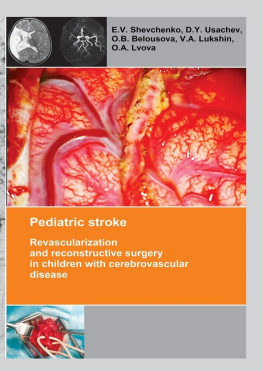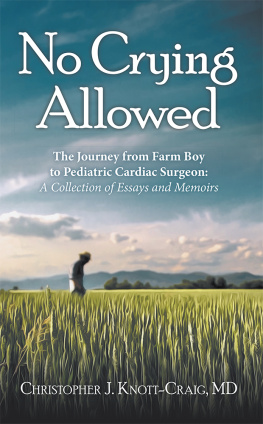Catherine Musemeche - Small: Life and Death on the Front Lines of Pediatric Surgery
Here you can read online Catherine Musemeche - Small: Life and Death on the Front Lines of Pediatric Surgery full text of the book (entire story) in english for free. Download pdf and epub, get meaning, cover and reviews about this ebook. year: 2014, publisher: Dartmouth College Press, genre: Science fiction. Description of the work, (preface) as well as reviews are available. Best literature library LitArk.com created for fans of good reading and offers a wide selection of genres:
Romance novel
Science fiction
Adventure
Detective
Science
History
Home and family
Prose
Art
Politics
Computer
Non-fiction
Religion
Business
Children
Humor
Choose a favorite category and find really read worthwhile books. Enjoy immersion in the world of imagination, feel the emotions of the characters or learn something new for yourself, make an fascinating discovery.
- Book:Small: Life and Death on the Front Lines of Pediatric Surgery
- Author:
- Publisher:Dartmouth College Press
- Genre:
- Year:2014
- Rating:4 / 5
- Favourites:Add to favourites
- Your mark:
- 80
- 1
- 2
- 3
- 4
- 5
Small: Life and Death on the Front Lines of Pediatric Surgery: summary, description and annotation
We offer to read an annotation, description, summary or preface (depends on what the author of the book "Small: Life and Death on the Front Lines of Pediatric Surgery" wrote himself). If you haven't found the necessary information about the book — write in the comments, we will try to find it.
Literate, moving, and illuminating, Small is an unforgettable look inside the world of a pediatric surgeon
Small: Life and Death on the Front Lines of Pediatric Surgery — read online for free the complete book (whole text) full work
Below is the text of the book, divided by pages. System saving the place of the last page read, allows you to conveniently read the book "Small: Life and Death on the Front Lines of Pediatric Surgery" online for free, without having to search again every time where you left off. Put a bookmark, and you can go to the page where you finished reading at any time.
Font size:
Interval:
Bookmark:
small
Life and Death on the Front Lines of Pediatric Surgery
CATHERINE MUSEMECHE, MD
DARTMOUTH COLLEGE PRESS
Hanover, New Hampshire
Dartmouth College Press
An imprint of University Press of New England
www.upne.com
2014 Catherine Musemeche
All rights reserved
For permission to reproduce any of the material in this book, contact Permissions, University Press of New England, One Court Street, Suite 250, Lebanon NH 03766; or visit www.upne.com.
Conch (p. v), 1948 by E. B. White. Used by permission of the Estate of E. B. White. All rights reserved.
While all of the events in this book are true, the names and personal characteristics of the patients involved have been changed to protect their privacy. Any resulting resemblance to other persons, living or dead, is entirely coincidental and unintentional.
Library of Congress Cataloging-in-Publication Data
Musemeche, Catherine, author.
Small: life and death on the front lines of pediatric surgery / Catherine Musemeche.
p.; cm.
Includes bibliographical references and index.
ISBN 978-1-61168-442-1 (cloth : alk. paper)
ISBN 978-1-61168-635-7 (ebook)
I. Title. [DNLM: 1. Surgical Procedures, OperativePersonal Narratives. 2. Child. 3. General SurgeryhistoryPersonal Narratives. 4. Infant. 5. PediatricshistoryPersonal Narratives. WO 925]
RD27.35.B47 617.092dc23
[B] 2014014173
conch
Hold a baby to your ear
As you would a shell:
Sounds of centuries you hear
New centuries foretell.
Who can break a babys code?
And which is the older
The listener or his small load?
The held or the holder?
(E. B. WHITE)
From the beginning, pediatric surgeons had to insist on their very existence at the same time that they were inventing the techniques and tools that would enable them to save the lives of the most vulnerable members of our population, our children. C. Everett Koop stayed late at the hospital filing rubber tubes so they would fit in the tiny airways of premature infants he would operate on the next day. Barbara Barlow, told repeatedly that women had no place in the operating room except as nurses, went on to become the first full-time pediatric surgeon in Harlem and built over one hundred playgrounds along the way. Melvin Smith refused to believe that a baby could not be saved simply because a device to straighten a tiny misshapen chest had not yet been invented.
Those of us who have been fortunate to practice pediatric surgery know that we stand on the shoulders of the giants who came before us in this unheralded field of medicine, men and women without whose perseverance in the face of adversity our specialty would not exist.
I had two goals in writing this book. One was to bring the reader into the operating room, the newborn intensive care unit, the emergency room, and to the bedside to experience what it is like to do this intense, demanding, and sometimes lonely job of a pediatric surgeon. The second was to bring to life the stories of individuals who achieved milestones in the field. While some of these stories are well known in the medical world, others have been buried in the past. All, however, demonstrate the ingenuity and tenacity of surgeons who refused to give up just because a clinical problem seemed next to impossible to solve.
This work is not intended as a comprehensive history of pediatric surgery. It is, rather, one persons attempt to acknowledge some specific accomplishments that demonstrate the courage, persistence, and unselfish devotion one needs to care for sick and injured childrenin other words, to be a pediatric surgeon.
Stitch, I say to the scrub nurse.
I hold out my hand, waiting. Instead of keeping up with me, the next suture ready to slap into my palm, shes hit a snag trying to pull the suture out of the package and load the needle in the gold-handled needle holder. I wish I could reach across the instrument tray and do it myself, but I cant move. If I look away, Ill lose my place, and that will only delay me further. Im focusing on an area no bigger than a postage stamp through a pair of surgical loupes that magnify my limited view. I can see the exact spot where the next stitch needs to go, between two gaping edges of intestine, the width of a matchstick.
Lets go, I say. Lets get this finished.
I know I seem impatient, but it is not because Im in a hurry to get to something else. My only focus at the moment is on this baby, Clare. I know that every moment she is under the drapes on the operating room table her life is at risk. Born eight weeks early, she weighs only four pounds. A breathing tube no bigger than a straw is keeping her alive during this operation. The correct position of this tube, inside her trachea, is measured in millimeters. If it is accidentally pushed in or pulled out, even a minuscule amount, her lungs will fail to expand and deflate and an alarm will go off.
Any interruption in ventilation will cause us to stop operating. The anesthesiologist will have to check the breathing tube and adjust it as needed. If the tube completely dislodges, the oxygen level in the bloodstream will plummet and within seconds the babys heart, deprived of oxygen, will start to slow dangerously. When that happens, the baby will be close to cardiac arrest. And if her heart does stop beating and normal blood circulation ceases, not only will this interrupt the operation, it could end it before we finish repairing the congenital malformation we came here to fix. We will have to staple everything closed and get out as quickly as possible.
In other words, a complication like this can result in disaster, a nightmare for surgeon and patient alike, and I had seen it before.
Three decades ago, when I was training to be a surgeon, I was assisting in an operation to repair bilateral inguinal (groin) hernias, persistent openings between the lining of the abdomen and the scrotum, in a premature baby boy with chronic lung disease. This is normally a straightforward repair that requires making a small incision on either side of the lower abdomen and locating and tying off a tissue sac. But on this particular morning, when the pediatric surgeon and I were about to finish and close the skin, the breathing tube slipped down too far, into the right-side bronchus, so that only the right lung was being ventilated.
Within seconds, the infants oxygen level dropped, his heart rate slowed, and the anesthesiologist disconnected the ventilator and started bagging the baby by hand to inflate his scarred and stiffened lungs. In his excitement to correct the problem, he used too much force. The pressure blew out both lungs like they were dime-store balloons, rendering them temporarily useless. The chest filled up with air, which compressed the lungs and kept them from expanding at all.
The surgeon and I pulled off the drapes and started CPR using two fingers, rather than the weight of an entire hand, to compress the undersized newborns heart. Then we incised both sides of the chest with our scalpels and slid small drainage tubes between ribs as thin and pliable as Q-tips. Within seconds, the air drained out of the chest cavity and the tiny lungs reexpanded. The heart started beating again, and the baby stabilized. We prepped the field and finished closing.
Thats the first time Ive ever done bilateral hernias and bilateral chest tubes at the same time, the surgeon said. A nervous laugh spilled out to punctuate his relief.
Everyone in the room knew how close we had come to losing that baby when no one was expecting it. Hernia operations are not usually considered high risk. But because we were working on a baby who weighed four pounds rather than the usual nine, a baby who had been in the neonatal intensive care unit the entire two months of his life and had chronic lung disease, the margin for error was slim enough to be virtually nonexistent.
Font size:
Interval:
Bookmark:
Similar books «Small: Life and Death on the Front Lines of Pediatric Surgery»
Look at similar books to Small: Life and Death on the Front Lines of Pediatric Surgery. We have selected literature similar in name and meaning in the hope of providing readers with more options to find new, interesting, not yet read works.
Discussion, reviews of the book Small: Life and Death on the Front Lines of Pediatric Surgery and just readers' own opinions. Leave your comments, write what you think about the work, its meaning or the main characters. Specify what exactly you liked and what you didn't like, and why you think so.













